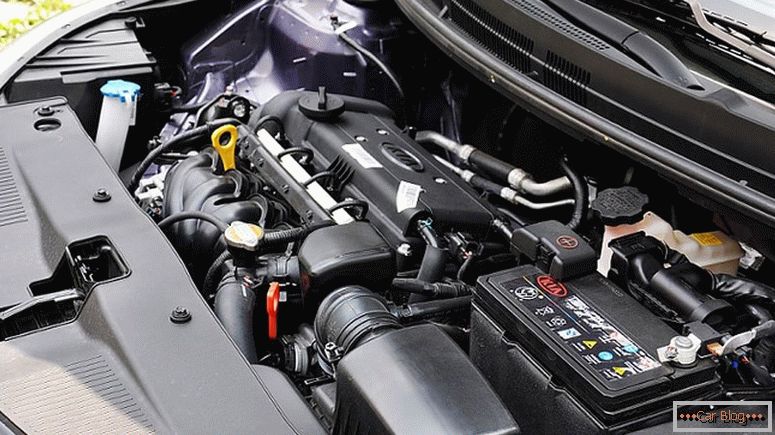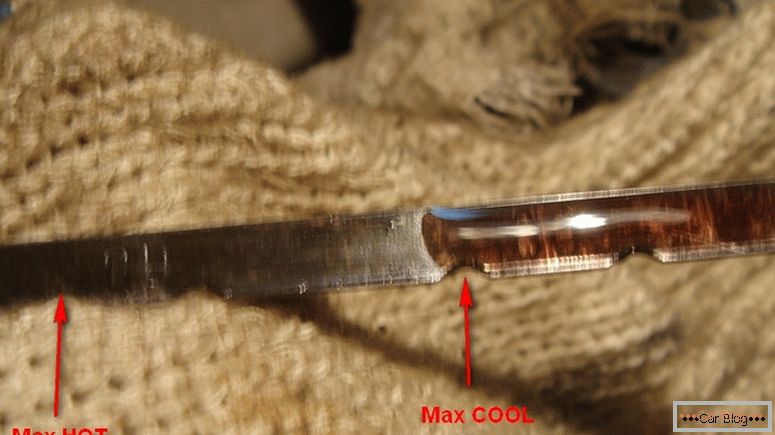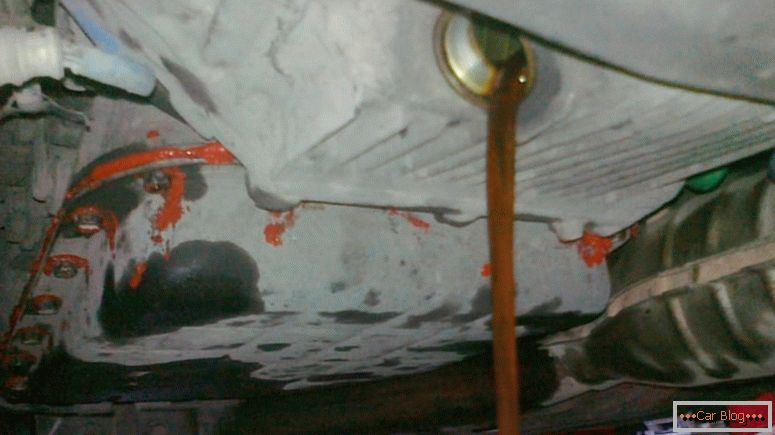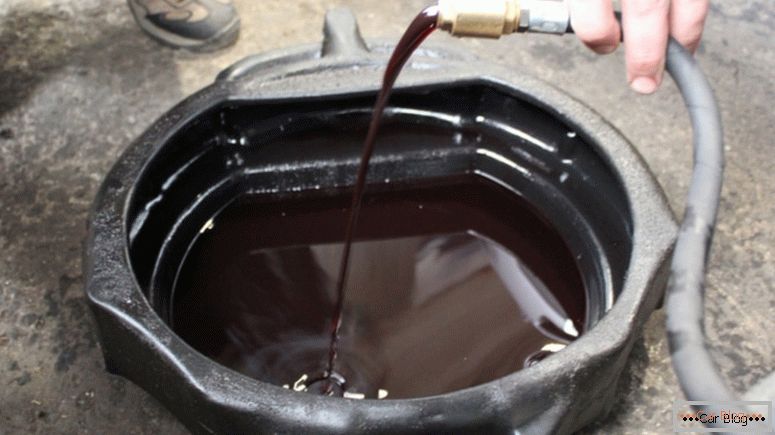The procedure for checking the lubricant in the automatic transmission is simple enough for those car owners who know what to look for and where it is located. But for beginners, the question of how to check the oil in the automatic transmission causes certain difficulties and difficulties.
Content
- 1 Process features
- 2 Checking the oil level in the automatic transmission
- 2.1 Box with probe
- 2.2 Box without probe
- 3 Consequences of changing the oil level
Process features
Having determined the location of the gearbox on the car, you should find out what type it has. Automatic transmission can be with a probe or without it. It is very easy to understand. Looking under the hood you need to find bright stylus handles that are used to control the oil level. The presence of two such pens indicates that the automatic box has a probe that allows you to determine the state of the fluid.

Oil dipstick (red handle)
Most cars with front-wheel drive gauge, located on the right side in the direction of the car, measures the amount of oil in the engine. The dipstick, which is located on the left side in the direction of travel, displays the fluid level directly in the automatic transmission. It should be remembered that the probe of the automatic transmission in most rear-wheel drive vehicles with a longitudinal placement of the power unit is located in a special opening between the rear wall of the engine and the engine compartment. With this arrangement, the probe is not noticeable, so you will need to look for it.
If there is only one pen, then this means that the automatic transmission does not have a dipstick. Then the car is raised on a special lift and unscrew the control plug, which is used to determine the level of oil. It is not recommended to carry out such a procedure yourself, as it is possible to completely remain without oil. In fact, the probe is not on many models of European brands such as: Citroen, Mercedes-Benz, Volkswagen, Opel and others.
Check the oil level in the automatic transmission
First of all, to check the oil in an automatic box of any type, put the car on a flat surface and switch to the Parking mode. Many manuals for the machine say that checking the oil in the gearbox should be done on a warm engine to a temperature of 90 degrees. To do this, you will need to travel a distance of 10 to 20 km. On most models, you need to perform this procedure directly on a running motor. To improve the quality of the measurement, it is advisable to check the oil level on a cooled engine (such actions can be carried out only at temperatures above 0 degrees, otherwise the data obtained will be inaccurate).

Automatic probes have a notch of oil level for "cold" and "hot" measurement
Measurement procedure:
See also: How often to change the oil in the gearbox and automatic mechanicsBox with probe
Almost all the oil dipstick automatic transmission have four special notches. These are Min and Max for cold oil and similar labeling for hot. Notches can be on the same or different sides of the probe. When performing a test on a heated engine, the level should be between the upper marks, and in the case of a cold motor, between the lower ones. Some car models have a dipstick with only two notches. Then the amount of liquid should not be higher than Max and lower than Min for both cases.
There are types of automatic transmissions where the oil level sometimes changes spontaneously. This effect arises due to the large number of cavities inside the automatic box. In some cases they are filled with oil, and in other conditions they are not. For complete confidence in the accuracy of the results obtained, it is worth checking the test several times at regular intervals (in a day or two). If for 3-4 procedures the oil level in the automatic transmission was constantly between Min and Max, then the fluid in the gearbox is enough and nothing needs to be done.
Box without probe

In vehicles not equipped with a special dipstick, check the oil level using a control plug
In such an automatic transmission, checking the oil level takes much longer and will require certain skills. In fact, the level is not checked, but re-set. An automatic transmission without a probe has a special overflow system. It consists of a tube that is installed directly into the drain hole of the pallet and a plug that covers the tube opening. The optimum oil level determines the height of the tube. Unscrewing the control plug allows you to drain excess oil, which is located above the level of the tube opening.
This system is used to prevent possible overflow of oil, which adversely affects the automatic transmission. Moreover, such a mechanism creates many difficulties, since it is impossible to check the level of contamination and the level of oil in the box in the usual way. For this procedure, raise the front part of the machine on jacks or send it to the lift. Do not forget to stick to the horizontal position of the car. The engine must be preheated. Before checking, you should not make a long trip, as this greatly heats the oil.

To establish the optimum level of oil, it is necessary to top up until the liquid starts to drip from the drain plug (for vehicles not equipped with an oil dipstick)
In the process of unscrewing the drain plug, you must be prepared to leak a small amount of oil that has fallen into the tube as a result of the functioning of the box. This oil can be used to determine the degree of contamination of the entire oil fluid. Next, you need to add about 100-200 grams of new oil in the neck of the automatic transmission and see how it flows through the drain hole. The fluid must be added until it starts to drip. This suggests an optimal level of oil. Since the procedure has certain difficulties, the owners of such automatic boxes prefer to set the oil level at a good service station. Of course, this approach increases the total cost of operating the machine, but completely eliminates the owner from unnecessary fuss with the gearbox.
See also: How does an automatic transmissionEffects of changing the oil level
The reduced amount of oil in the box can cause the following problems:
- the oil resource decreases and its temperature condition is broken;
- the pump will trap air, which will turn the liquid into an undesirable air-oil emulsion and will cause a decrease in pressure in the system. As a result, the automatic transmission heat sink is disrupted, the transmission is lost and the process of lubrication of the elements of the automatic box deteriorates.
An excessive oil level leads to the following consequences:
- fluid will cover the rotating parts of the automatic transmission. As a result, the oil foams and has a similar negative effect, as with an underestimate;
- foaming causes an increase in the volume of the oil and its subsequent release through the breather.
Very often, individual air bubbles arising on the dipstick are confused with foaming oil. The foamed liquid is evenly covered with fine bubbles. Operating the car in this mode will result in automatic transmission failure.
To solve the problem, stop the engine, allow the oil to stand, check it and, without starting the engine, adjust the level to normal.

If the oil is cloudy or has extraneous inclusions, it is necessary to urgently diagnose the box.
Different types of oil for an automatic box differ in a smell and color. There are general rules for checking the quality of oil in automatic transmissions:
- Good oil has a transparent appearance, it has no foreign inclusions and a burnt smell.
- Clean the dipstick on the dipstick and only then do an oil check. The absence of overlaps indicates that the probe has not been used for a long time.
- Changing the oil in the box, you need to remember what color and smell has a liquid.
Changing any of these parameters indicates the occurrence of a malfunction. In this case, it is best to go to the auto repair service for a thorough diagnosis of the automatic transmission status.



